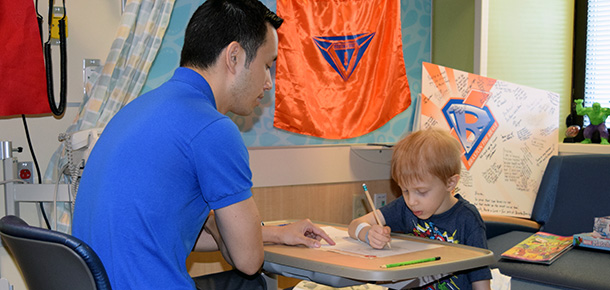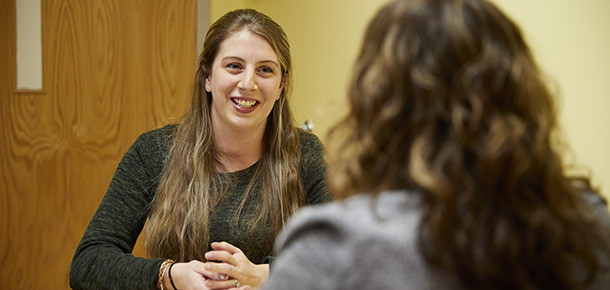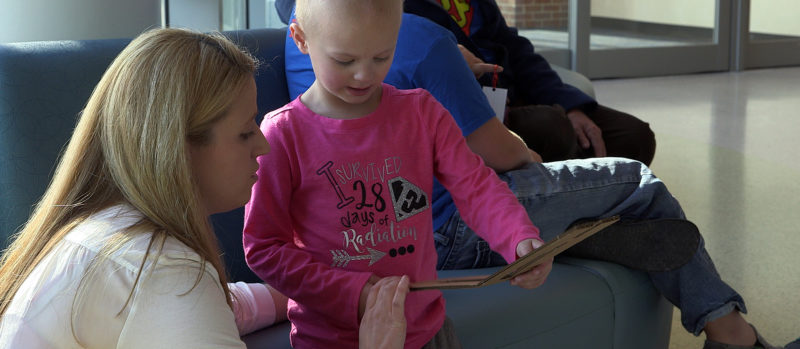David Cheung walks onto the inpatient unit in the Cancer and Blood Diseases Institute (CBDI) just before 11 on a Monday morning, carrying a bag filled with school supplies marked “Braxton.”
He finds Braxton’s room, peaks through the blinds to make sure the 6 year old is awake and alert, then knocks on the door of 565 and enters. David greets mom, Alicia, and gets re-acquainted with Braxton before the two get down to business.
Today’s lesson begins with telling time on a big yellow demonstration clock. Braxton’s Hospital Teacher included the clock in the bag with the rest of his learning materials for the week based on the guidance of Braxton’s Kindergarten teacher at school back home, Mrs. Oien.
It’s a scene that plays out every weekday, all year round, on the hematology/oncology floor thanks to the CBDI Hospital School Program. Each year the program serves about 300 unique students in pre-school through 12th grade from local, national and international schools. The goal is to help students maintain their academic skills, return some normalcy to their daily routines, and keep their development on track with their peers while they are receiving care at the medical center.
David is a full-time employee at Cincinnati Children’s. He has been tutoring kids at the hospital for more than five years – all on a volunteer basis. David’s supervisor allows him to make time in between his busy workday schedule as a research assistant in the Division of Biomedical Informatics to volunteer one day per week for two hours. He is one of a dozen regular hospital volunteers who assist the program’s six teachers.
On any given day, staff members and volunteers provide individualized instruction in a variety of subjects, from Shakespeare and high-level mathematics to simple addition and subtraction. Kids who are healthy enough to learn are offered school five days a week. Unlike the Child Life School Program, there is no classroom where CBDI patients go to learn because so many of them are immunocompromised. Instead, the teaching staff and volunteers go door-to-door to teach children at bedsides.
Each child’s school back home provides guidance for instruction, many times sending the books and materials – and in some cases an Individual Learning Plan (IEP) – for teachers and tutors to use. All the schoolwork done here at the hospital gets documented so that children can get credit for their work when they return home. For many CBDI patients, success in school is tied into their hope for the future. Some work with a teacher or tutor for months, or even years, depending on their treatment plan.
 Braxton has leukemia and has been a patient for about six months. After he masters telling time on the big yellow demonstration clock, David puts it back in the bag of school supplies and pulls out a workbook. He opens the workbook, reads the instructions aloud, and hands Braxton a pencil.
Braxton has leukemia and has been a patient for about six months. After he masters telling time on the big yellow demonstration clock, David puts it back in the bag of school supplies and pulls out a workbook. He opens the workbook, reads the instructions aloud, and hands Braxton a pencil.
The irony of today’s lesson about telling time is not lost on David.
“Everybody has time – if you make the time – to do something good for somebody else”, he says. David volunteers because he understands that his time tutoring is just as important as his day-to-day responsibilities in the research lab. The toughest part of either of his jobs at the medical center, he admits, is saying goodbye to a child – for both the good reasons and the bad – when time is up.
Sitting across from Braxton, David uses another pencil to follow along, upside down, in the notebook as Braxton draws in the minute and hour hands on the blank clock faces that dot the page. For Braxton, the lesson continues.
For more information about the CBDI hospital school program, call 513-803-1022. To learn more about volunteering at the hospital, contact Volunteer Services at 513-636-4396 or email volunteerservices@cchmc.org.






